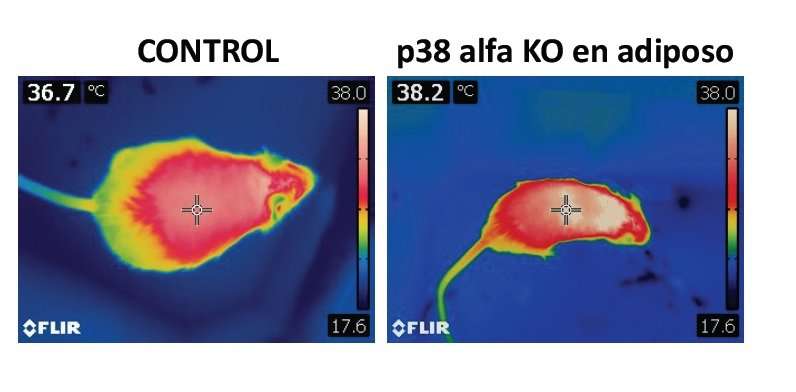Researchers report protein kinase as the switch controlling obesity and diabetes

One of the research lines targeting the worldwide obesity epidemic is the manipulation of brown adipose tissue, a 'good' type of fat that burns lipids to maintain an appropriate body temperature. Researchers at the Centro Nacional de Investigaciones Cardiovasculares Carlos III (CNIC) have now uncovered the mechanism by which brown fat cells are activated to generate heat and eliminate excess fat. The results, published in PLoS Biology, have potential clinical implications for the treatment of obesity and related diseases like diabetes.
Obesity is a global epidemic, with an estimated 2200 million people affected by excess weight or obesity. This situation has converted obesity into a priority concern of the World Health Association (WHO).
In recent years, research interest has centered on understanding the function of adipose tissue, particularly brown adipose tissue, as a route to tackling the problems caused by obesity. Body fat is essential for maintaining a correct energy balance and for regulating body temperature. But not all fat tissue is the same, and there are two types: white adipose tissue, which stores excess calories, and brown adipose tissue, which burns fats to generate heat. Overturning the old view that fat has no essential function, research in recent years indicates that activation of brown adipose tissue could be the solution to the problem of obesity.
The research group led by Dr. Guadalupe Sabio has been pursuing a promising research line aimed at understanding how brown adipose tissue can be activated in order to burn the excess fat that accumulates in obese individuals. In collaboration with the Instituto de Investigación Biomédica de Salamanca (IBSAL) and Salamanca University Hospital, this CNIC group has identified a new mechanism with future clinical applications. In more than 150 human samples, the researchers have demonstrated that the protein kinase p38 alpha is more abundant in the adipose tissue of obese individuals. According to researcher Nuria Matesanz, the finding suggests that "p38 alpha may regulate UCP1, an important protein for brown fat activation that dissipates the energy generated from burning excess fat as heat."
In experiments with mice genetically modified to lack p38 alpha, the research team found that the absence of this protein in adipose tissue prevents the mice from becoming obese even when fed a high-fat diet. This protection, explains research team member Ivana Nikolic, "is due to the fact that the lack of p38 alpha activates brown adipose tissue, which eliminates excess white fat in the form of heat." Just as important, the study shows that mice lacking p38 alpha are protected against diabetes and fatty liver disease.
Lead author Dr. Sabio says, "These results suggest that pharmacological inhibition of p38 alpha could offer a route to the treatment of obesity."
The study also reveals another important finding: p38 alpha controls the activation of another protein of the same family, p38 delta, which is responsible for temperature regulation. The authors explain, "When mice are exposed to low temperatures, p38 delta is activated, increasing the activity of brown fat." In mice lacking p38, p38 delta is overactivated, resulting in protection against obesity.


















